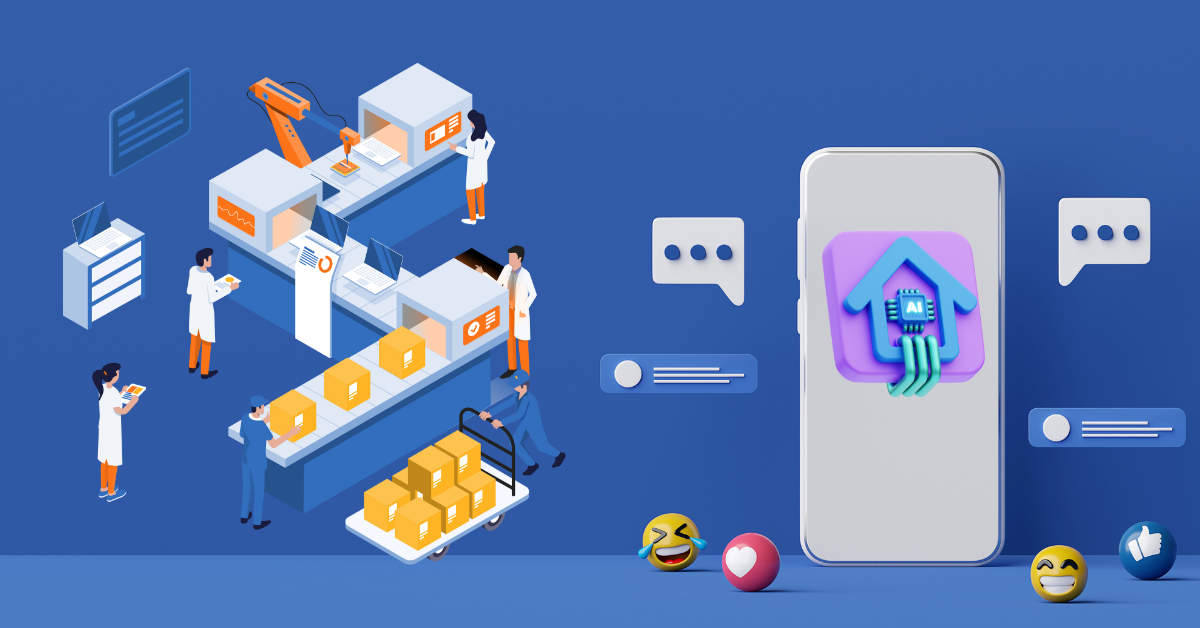Social media automation has rapidly gained prominence in recent times, with many businesses and individuals leveraging its power to save time, increase efficiency, and streamline their social media marketing efforts. Social media automation refers to the use of software tools to automate social media tasks such as scheduling posts, monitoring comments, and managing social media accounts.
What is social media automation?
Social media automation can be defined as the process of using tools and software to automatically manage and perform repetitive tasks associated with your social media accounts. This allows you to optimize your time and resources while still maintaining an active and engaging online presence.
Social media managers can save valuable time for higher-priority tasks by utilizing tools that automate post-scheduling, basic customer service, and analytics reports.
What can you automate in social media marketing?
In social media marketing, a surprising number of tasks can be automated, freeing up your time for more strategic planning and creative endeavors. Here’s a breakdown of some key areas where automation can be your digital assistant:
Content Management
Content management refers to the process of organizing and managing digital content. This can include creating, editing, publishing, and archiving various types of content such as articles, images, videos, audio files, and more.
Effective content management is essential for businesses and organizations that need to maintain a large amount of content on their websites or other digital platforms. By properly managing content, businesses can ensure that their information is up-to-date, easily accessible, and properly organized for their target audience.
- Scheduling posts: Publish content across multiple platforms at optimal times without needing to be there physically.
- Content curation: Find and share relevant content from other sources, saving you time from manual searching.
- Repurposing content: Automatically share your existing content in different formats on different platforms to maximize reach.
- Image editing: Use preset filters and resizing tools to ensure consistent visual branding and save editing time.
Community Engagement
Community engagement is an important aspect of building strong and healthy communities. It involves actively involving members of the community in decision-making processes, listening to their concerns and ideas, and working collaboratively to find solutions to issues that affect the community. Community engagement can help to build trust, promote inclusivity, and ensure that everyone has a voice in shaping the future of their community.
- Auto-responding to comments and messages: Set up pre-defined responses for common questions or greetings, providing quicker replies to your audience.
- Monitoring brand mentions: Track conversations about your brand across platforms and respond to relevant discussions.
- Running contests and giveaways: Automate entry processes and winner selection, streamlining the experience for participants.
Advertising and Promotion
Advertising and promotion are important aspects of any business. They help to create awareness about products or services and attract potential customers. There are various types of advertising and promotion strategies that businesses can use, such as print ads, TV commercials, social media marketing, and email campaigns. It’s important for businesses to choose the right mix of strategies that will reach their target audience effectively and efficiently.
- Budget management: Set daily or campaign-based budget limits for your social media ads to avoid overspending.
- Targeting and bidding: Utilize automated options to reach your ideal audience with the right bid strategies.
- Ad performance optimization: Let algorithms fine-tune your ad campaigns based on performance data, maximizing your return on investment.
Analytics and Reporting
Analytics and reporting are essential components of any successful business strategy. By analyzing data and generating reports, companies can make informed decisions about their operations, marketing efforts, and overall performance.
Whether it’s tracking website traffic, monitoring social media engagement, or measuring sales figures, analytics and reporting provide valuable insights that can help businesses stay competitive and adaptive to changing market conditions. With the right tools and expertise, organizations can leverage data to drive growth, improve efficiency, and achieve their goals.
- Generating automated reports: Track key metrics like engagement, reach, and website traffic based on pre-defined parameters.
- Competitive analysis: Use tools to track your competitors’ social media activity and performance, gaining valuable insights.
- Sentiment analysis: Understand the overall sentiment towards your brand on social media by automatically analyzing keywords and mentions.
Common mistakes when automating social media marketing
When it comes to automating social media marketing, there are a few common mistakes that businesses and marketers can make. Here are some of them:
1. Over-automating: While automation can save time and effort, over-automating can make your social media presence feel robotic and impersonal. It’s important to balance automation with human interaction and engagement.
2. Ignoring engagement: Social media is all about building relationships and engaging with your audience. If you focus solely on automation and don’t take the time to respond to comments and messages, you risk losing the trust and loyalty of your followers.
3. Lack of personalization: Generic, one-size-fits-all content won’t cut it on social media. To stand out and connect with your audience, you need to customize your content and messaging to fit their interests and needs.
4. Failure to monitor: Automation can lead to mistakes and errors, so it’s important to monitor your accounts regularly to ensure that everything is running smoothly and as intended.
By avoiding these common mistakes and finding the right balance between automation and human interaction, businesses can effectively leverage social media to build their brand, engage their audience, and drive results.
4 top social media automation tools
There are many social media automation tools available that can help businesses and marketers save time and streamline their social media marketing efforts. Here are four top social media automation tools:
Hootsuite
Hootsuite is a web-based tool that allows users to manage all of their social media accounts in one place. It was founded in 2008 and has since become one of the most popular social media management tools available. It offers a comprehensive suite of tools designed to streamline social media activities across major platforms like Facebook, Instagram, Twitter, LinkedIn, and more.
Features:
- Content Management: Schedule posts, create drafts, collaborate with team members, and leverage bulk actions for efficient content management.
- Social Listening: Track brand mentions, monitor industry trends, and analyze sentiment across the social media sphere.
- Engagement: Respond to comments and messages, manage communities, and personalize interactions with your audience.
- Analytics & Reporting: Gain insights into performance metrics, track campaign effectiveness, and generate reports for data-driven decision-making.
- Collaboration: Assign tasks, set permissions, and manage different user roles within your organization.
- Integrations: Connect Hootsuite with other marketing tools like Canva, Mailchimp, and Google Analytics for a more unified workflow.
Pros:
- User-friendly interface: Navigating Hootsuite is relatively intuitive, even for beginners.
- Multi-platform management: Manage numerous social media accounts from a single dashboard.
- Content scheduling: Plan and publish content in advance for consistent engagement.
- Team collaboration features: Facilitate teamwork and shared responsibilities.
- Extensive analytics: Track performance and measure ROI accurately.
- Free plan available: A basic plan is perfect for personal use or small businesses.
Cons:
- Limited features in free plan: The free version offers restricted access to some functionalities.
- Pricey for individual users: Paid plans can be expensive for individual users compared to competitors.
- Steeper learning curve for advanced features: Mastering some advanced functionalities may require some effort.
- Limited scheduling for free plan: The free plan restricts the number of scheduled posts.
Pricing Model
Hootsuite offers a range of pricing plans starting at $19/month for the Professional plan and going up to $599/month for the Business plan. Custom pricing is also available for larger organizations.
Best For: Hootsuite is a great tool for businesses of all sizes looking to streamline their social media management and increase their online presence.
Buffer
Buffer is a social media management tool that allows businesses and individuals to schedule, publish, and analyze their social media content. With its user-friendly interface and powerful features, Buffer has become a go-to tool for managing social media accounts across various platforms.
Features:
– Scheduling: Buffer allows users to schedule their social media posts in advance, saving time and effort in the long run.
– Analytics: Users can analyze the performance of their social media posts, track engagement metrics, and monitor their social media growth.
– Collaboration: Buffer allows multiple team members to collaborate on social media content creation and publishing.
– Content creation: Users can create and store their social media content within Buffer, making it easier to manage and publish.
Pros:
– User-friendly interface: Buffer’s interface is easy to navigate, making it accessible to users of all experience levels.
– Comprehensive analytics: Buffer’s analytics provide users with detailed insights into their social media performance, allowing them to make data-driven decisions.
– Cross-platform integration: Buffer integrates with multiple social media platforms, making it easy to manage all social media accounts from one place.
– Affordable pricing: Buffer offers a range of pricing plans, including a free plan with limited features, making it accessible to businesses and individuals of all sizes.
Cons:
– Limited engagement features: Buffer’s focus is primarily on scheduling and publishing content, with limited features for engaging with followers.
– Limited automation: While Buffer allows users to schedule and publish content in advance, it has limited automation features compared to other social media management tools.
Pricing model:
Buffer offers a range of pricing plans, including a free plan with limited features. Paid plans start at $15/month for the Pro plan, $99/month for the Premium plan, and custom pricing for the Business plan.
Best for:
Buffer is best for businesses and individuals who want to save time and effort in managing their social media accounts. It is also ideal for those who want to analyze their social media performance and make data-driven decisions.
hootsuite review including an introduction, features, pros and cons, pricing model and best for.
Meta Business Suite
Meta Business Suite is a comprehensive software solution that includes a variety of business tools designed to help companies manage their operations more efficiently.
Meta Business Suite is an all-in-one business software suite that includes a range of tools for managing sales, marketing, customer service, project management, and more. The software is designed to help businesses streamline their operations and improve overall productivity.
Features:
- Unified Management: Manage Facebook pages, Instagram profiles, and ad campaigns from a single dashboard.
- Content Creation & Scheduling: Create and schedule posts for both platforms simultaneously.
- Community Management: Respond to comments and messages across both platforms.
- Analytics & Insights: Track performance metrics, gain audience demographics, and access in-depth data.
- Ad Management: Create, manage, and optimize ads across Facebook and Instagram.
- Collaboration: Assign roles and permissions to team members for collaborative work.
- Commerce Tools: Manage product listings, orders, and customer service inquiries.
- Integrations: Connect with other business tools like Shopify and HubSpot for increased efficiency.
Pros:
- Free to use: No upfront costs for basic functionalities.
- Simplified interface: User-friendly and intuitive platform for efficient navigation.
- Centralized management: Manage both Facebook and Instagram in one place.
- Comprehensive insights: Gain valuable data to inform your marketing strategies.
- Advertising potential: Reach a wide audience across two major platforms.
- Evolving platform: Regular updates and new features offer continuous improvement.
Cons:
- Limited customization: Interface might seem rigid for advanced users.
- Learning curve: Mastering advanced features requires some effort.
- Data privacy concerns: Meta’s data collection practices raise concerns for some users.
- Potential reach limitations: Organic reach on Facebook and Instagram can be challenging.
- Limited customer support: Free plan doesn’t offer dedicated support options.
Brandwatch
Brandwatch is a social media listening and analytics tool that helps businesses monitor, analyze, and respond to online conversations and trends. With its comprehensive features, it allows users to track and measure their brand’s reputation, customer sentiment, and competitive landscape across various social media platforms.
Features:
Brandwatch offers a range of features that includes:
1. Social Listening: It allows users to track mentions of their brand, competitors, and industry keywords across social media platforms, forums, blogs, news outlets, and review sites.
2. Audience Analysis: It provides insights into users’ demographics, interests, and behaviors to help businesses better understand their target audience.
3. Influencer Identification: It helps users identify and engage with relevant influencers to drive brand awareness and advocacy.
4. Image Analysis: It uses AI-powered image recognition technology to analyze images and videos for brand logos and products.
5. Crisis Management: It helps businesses monitor and respond to negative mentions and crisis situations in real-time, enabling them to manage their online reputation effectively.
Pros:
1. Comprehensive social media monitoring and analytics capabilities.
2. Intuitive and user-friendly interface.
3. Powerful sentiment analysis and data visualization tools.
4. Robust reporting and customization options.
5. Excellent customer support.
Cons:
1. Expensive pricing plans.
2. Limited integration options with third-party tools.
3. Steep learning curve for beginners.
4. Some features may require additional training or expertise.
Pricing Model:
Brandwatch offers a range of pricing plans to suit different business needs and budgets. Its plans start from $800 per month for the Basic plan and go up to $3,200 per month for the Enterprise plan. It also offers a custom plan for businesses with unique requirements.
Best For:
Brandwatch is best suited for businesses looking to monitor and analyze their brand’s reputation, social media performance, and customer sentiment across various channels. It is also ideal for businesses looking to identify influencers, track their competition, and manage their online reputation effectively.
ChatGPT
ChatGPT is a cloud-based chatbot builder platform that allows businesses to create AI-powered chatbots without any coding knowledge. The platform offers various features such as multi-language support, integrations with popular messaging apps, and easy-to-use interface. In this review, we will explore the features, pros, and cons of ChatGPT, its pricing model, and who it’s best for.
Features:
ChatGPT offers a range of features that make it easy for businesses to create chatbots. These features include:
1. Multi-language support: ChatGPT supports multiple languages, making it easy for businesses to create chatbots that can interact with users in their preferred language.
2. Intuitive interface: The platform has an easy-to-use interface that doesn’t require any coding knowledge. Businesses can drag and drop elements to create their chatbots.
3. Integrations: ChatGPT integrates with popular messaging apps such as Facebook Messenger, Slack, and WhatsApp, making it easy for businesses to reach their audience on these platforms.
4. Analytics: The platform provides analytics that allow businesses to track their chatbot’s performance and make adjustments to improve its effectiveness.
Pros:
1. Easy to use: ChatGPT’s drag-and-drop interface makes it easy for businesses to create chatbots without any coding knowledge.
2. Multi-language support: The platform supports multiple languages, making it easy for businesses to cater to a global audience.
3. Integrations: ChatGPT integrates with popular messaging apps, making it easy for businesses to reach their audience on these platforms.
4. Analytics: The platform provides analytics that allow businesses to track their chatbot’s performance and make adjustments to improve its effectiveness.
Cons:
1. Limited customization: ChatGPT’s templates and pre-built elements may limit the level of customization that businesses can achieve.
2. Cost: ChatGPT’s pricing model may be expensive for small businesses that are just starting out.
Pricing Model:
ChatGPT offers a range of pricing plans to suit different business needs. The plans include:
1. Basic: $149 per month
2. Professional: $299 per month
3. Enterprise: Custom pricing
The Basic plan includes basic features such as unlimited chatbots, multi-language support, and analytics. The Professional plan includes all the features of the Basic plan plus additional features such as custom branding and integrations. The Enterprise plan includes all the features of the Professional plan plus custom pricing and custom features.
Best for:
ChatGPT is best for businesses that want to create AI-powered chatbots without any coding knowledge. The platform is ideal for businesses that want to reach their audience on popular messaging apps such as Facebook Messenger, Slack, and WhatsApp. ChatGPT is also suitable for businesses that want to cater to a global audience by supporting multiple languages.




